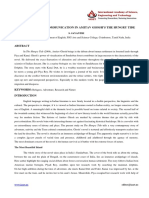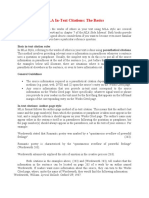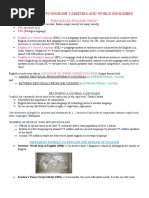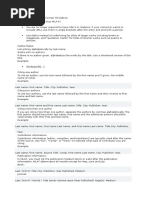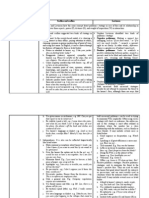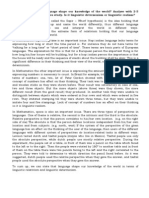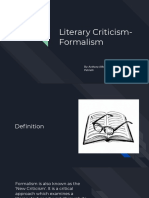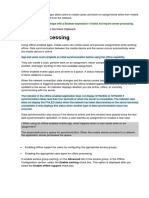What Is An Abstract
Uploaded by
ShazwanShahWhat Is An Abstract
Uploaded by
ShazwanShahWHAT IS AN ABSTRACT?
An abstract is a self-contained, short, and powerful statement that describes a larger work. Components
vary according to discipline. An abstract of a social science or scientific work may contain the scope,
purpose, results, and contents of the work. An abstract of a humanities work may contain the thesis,
background, and conclusion of the larger work. An abstract is not a review, nor does it evaluate the work
being abstracted. While it contains key words found in the larger work, the abstract is an original document
rather than an excerpted passage.
HOW DO I WRITE AN ABSTRACT?
The format of your abstract will depend on the work being abstracted. An abstract of a scientific research
paper will contain elements not found in an abstract of a literature article, and vice versa. However, all
abstracts share several mandatory components, and there are also some optional parts that you can decide
to include or not. When preparing to draft your abstract, keep the following key process elements in mind:
Reason for writing:
What is the importance of the research? Why would a reader be interested in the larger work?
Problem:
What problem does this work attempt to solve? What is the scope of the project? What is the main
argument/thesis/claim?
Methodology:
An abstract of a scientific work may include specific models or approaches used in the larger study.
Other abstracts may describe the types of evidence used in the research.
Results:
Again, an abstract of a scientific work may include specific data that indicates the results of the project.
Other abstracts may discuss the findings in a more general way.
Implications:
What changes should be implemented as a result of the findings of the work? How does this work add to
the body of knowledge on the topic?
(This list of elements is adapted with permission from Philip Koopman, How to Write an Abstract.)
ALL ABSTRACTS INCLUDE:
A full citation of the source, preceding the abstract.
The most important information first.
The same type and style of language found in the original, including technical language.
Key words and phrases that quickly identify the content and focus of the work.
Clear, concise, and powerful language.
ABSTRACTS MAY INCLUDE:
The thesis of the work, usually in the first sentence.
Background information that places the work in the larger body of literature.
The same chronological structure as the original work.
Checklist: Parts of an Abstract
Despite the fact that an abstract is quite brief, it must do almost as much work as
the multi-page paper that follows it. In a computer architecture paper, this means
that it should in most cases include the following sections. Each section is typically
a single sentence, although there is room for creativity. In particular, the parts may
be merged or spread among a set of sentences. Use the following as a checklist for
your next abstract:
Motivation:
Why do we care about the problem and the results? If the problem isn't
obviously "interesting" it might be better to put motivation first; but if your
work is incremental progress on a problem that is widely recognized as
important, then it is probably better to put the problem statement first to
indicate which piece of the larger problem you are breaking off to work on.
This section should include the importance of your work, the difficulty of
the area, and the impact it might have if successful.
Problem statement:
What problem are you trying to solve? What is the scope of your work (a
generalized approach, or for a specific situation)? Be careful not to use too
much jargon. In some cases it is appropriate to put the problem statement
before the motivation, but usually this only works if most readers already
understand why the problem is important.
Approach:
How did you go about solving or making progress on the problem? Did you
use simulation, analytic models, prototype construction, or analysis of field
data for an actual product? What was the extent of your work (did you look
at one application program or a hundred programs in twenty different
programming languages?) What important variables did you control, ignore,
or measure?
Results:
What's the answer? Specifically, most good computer architecture papers
conclude that something is so many percent faster, cheaper, smaller, or
otherwise better than something else. Put the result there, in numbers. Avoid
vague, hand-waving results such as "very", "small", or "significant." If you
must be vague, you are only given license to do so when you can talk about
orders-of-magnitude improvement. There is a tension here in that you
should not provide numbers that can be easily misinterpreted, but on the
other hand you don't have room for all the caveats.
Conclusions:
What are the implications of your answer? Is it going to change the world
(unlikely), be a significant "win", be a nice hack, or simply serve as a road
sign indicating that this path is a waste of time (all of the previous results are
useful). Are your results general, potentially generalizable, or specific to a
particular case?
WHAT SHOULD AN ABSTRACT INCLUDE?
Successful abstracts, in every discipline, will always achieve five key goals:
1. Title your research project.
Your title should be short and informative.
2. State your research question, aim, or scholarly goal.
What are the aims of your project?
This might be a yes/no question or an open-ended statement of what is being examined.
Your statement should be clear and concise -- typically 1-2 sentences.
3. Contextualize your project within existing knowledge or ideas.
Why is your project goal important?
How will your project produce new knowledge or perspectives?
What, within your field, motivated your project?
How is your project different from other projects?
What is the background and the research context of your creative work?
If your project presentation involves a performance with a lecture, how does your lecture
provide a research context for your performance?
You may want to reference one or two key sources.
You should explicitly connect your contextualization to your research.
4. Describe the methods or approach you used or will use.
How, specifically, is your project conducted?
What, specifically, is your project examining?
5. Describe your main conclusions, outcomes, products, or recommendations.
Your conclusion will be what your project contributed to the discipline or what new
knowledge your project created.
Explain the significance of your results or how your results might be generalized.
What your conclusions, outcomes, products, or recommendations hope to achieve or how
they might impact your audience.
If the project isnt complete, state the kinds of results you expect.
You might also like
- AASHTO T 27 - Sieve Analysis of Fine and Coarse Aggregates PDF75% (4)AASHTO T 27 - Sieve Analysis of Fine and Coarse Aggregates PDF40 pages
- Problem Sheet - 1: Figure 1. Conduction Band Figure 2. Valance Band0% (1)Problem Sheet - 1: Figure 1. Conduction Band Figure 2. Valance Band2 pages
- Advocacy of The Eclectic Approach To ESL/EFL Teaching in BangladeshNo ratings yetAdvocacy of The Eclectic Approach To ESL/EFL Teaching in Bangladesh9 pages
- Ijll-Trans Cultural Communication-Dr.s.jayanthiNo ratings yetIjll-Trans Cultural Communication-Dr.s.jayanthi4 pages
- Analysing Sentence Structure and Function-Part OneNo ratings yetAnalysing Sentence Structure and Function-Part One46 pages
- Bangladeshis Writing in English: L-R: Tahmima Anam, Razia Khan Amin and Kaiser HaqNo ratings yetBangladeshis Writing in English: L-R: Tahmima Anam, Razia Khan Amin and Kaiser Haq3 pages
- Introduction To English Varieties and World EnglishesNo ratings yetIntroduction To English Varieties and World Englishes7 pages
- An Introduction To Essay Writing - Kouicem Khadidja100% (1)An Introduction To Essay Writing - Kouicem Khadidja78 pages
- Williamlabovscontributiontolinguistics 101206160743 Phpapp01No ratings yetWilliamlabovscontributiontolinguistics 101206160743 Phpapp0121 pages
- Full download Second Language Acquisition and Lifelong Learning 1st Edition Singleton pdf docx100% (1)Full download Second Language Acquisition and Lifelong Learning 1st Edition Singleton pdf docx55 pages
- Problem and Prospect of Using Literature To Teach Writing in English As A Second Language0% (1)Problem and Prospect of Using Literature To Teach Writing in English As A Second Language5 pages
- Stylistic Analysis of Langston Hughes's Poem "Harlem" Lok Raj SharmaNo ratings yetStylistic Analysis of Langston Hughes's Poem "Harlem" Lok Raj Sharma10 pages
- ENG-116: Branches of Linguistics: Books) .Farmer, A. K Demers, R. A. A Linguistics WorkbookNo ratings yetENG-116: Branches of Linguistics: Books) .Farmer, A. K Demers, R. A. A Linguistics Workbook6 pages
- Text Linguistics and Language Teaching: Rogil Sanchez Quintana100% (1)Text Linguistics and Language Teaching: Rogil Sanchez Quintana17 pages
- Basic Concepts of Modern Linguistics: Language Et ParoleNo ratings yetBasic Concepts of Modern Linguistics: Language Et Parole9 pages
- Foundation of Literary Theory and CriticismNo ratings yetFoundation of Literary Theory and Criticism8 pages
- Psychological Factors in Language Learning-Crissel AnthonyNo ratings yetPsychological Factors in Language Learning-Crissel Anthony21 pages
- Linguistic Determinism & Linguistic RealismNo ratings yetLinguistic Determinism & Linguistic Realism1 page
- Lecture 1st Literary Stylistics and CriticismNo ratings yetLecture 1st Literary Stylistics and Criticism37 pages
- Tracing The Post Modern Elements in The Novels of Amitav GhoshNo ratings yetTracing The Post Modern Elements in The Novels of Amitav Ghosh5 pages
- Assignment: Kuch Ishq Kiya, Kuch Kaam Kiya: Department of EnglishNo ratings yetAssignment: Kuch Ishq Kiya, Kuch Kaam Kiya: Department of English3 pages
- Mla 8 Edition Quick Reference: NG Headi Ing Head RunnNo ratings yetMla 8 Edition Quick Reference: NG Headi Ing Head Runn12 pages
- Creole Composition: Academic Writing and Rhetoric in the Anglophone CaribbeanFrom EverandCreole Composition: Academic Writing and Rhetoric in the Anglophone CaribbeanNo ratings yet
- (Guinea 1994) A General Bilinear Fit For The Softening Curve of ConcreteNo ratings yet(Guinea 1994) A General Bilinear Fit For The Softening Curve of Concrete7 pages
- APA V345 Concrete Forming Design Construction Guide100% (1)APA V345 Concrete Forming Design Construction Guide29 pages
- Determination of DYNAMIC Young's Modulus of Concrete at Early Ages by Impact Resonance TestNo ratings yetDetermination of DYNAMIC Young's Modulus of Concrete at Early Ages by Impact Resonance Test8 pages
- Reliability Engineering Certification: Four-Course ProgramNo ratings yetReliability Engineering Certification: Four-Course Program2 pages
- Map Server For Visualizing Air Traffic Based On Data From A Remote Pseudo RadarNo ratings yetMap Server For Visualizing Air Traffic Based On Data From A Remote Pseudo Radar14 pages
- Differential geometry of manifolds Second Edition Lovett 2024 scribd downloadNo ratings yetDifferential geometry of manifolds Second Edition Lovett 2024 scribd download55 pages
- Welcome: Puskesmas Iv Denpasar Selatan (Public Health Centre)No ratings yetWelcome: Puskesmas Iv Denpasar Selatan (Public Health Centre)33 pages
- 99.poultry Breeding and Multiplication Center OkNo ratings yet99.poultry Breeding and Multiplication Center Ok21 pages
- Chapter 8 Solution Manual Accounting Information SystemsNo ratings yetChapter 8 Solution Manual Accounting Information Systems19 pages
- Federal Investigation Agency (FIA) : Recruitment TestNo ratings yetFederal Investigation Agency (FIA) : Recruitment Test4 pages
- Chapter Three Chapter Three The Multiple Linear Regression (MLR)No ratings yetChapter Three Chapter Three The Multiple Linear Regression (MLR)50 pages
- 11-09-2022 - SR - Super60 - Jee-Adv (2020-P2) - RPTA-01 - Key & Sol'sNo ratings yet11-09-2022 - SR - Super60 - Jee-Adv (2020-P2) - RPTA-01 - Key & Sol's10 pages








